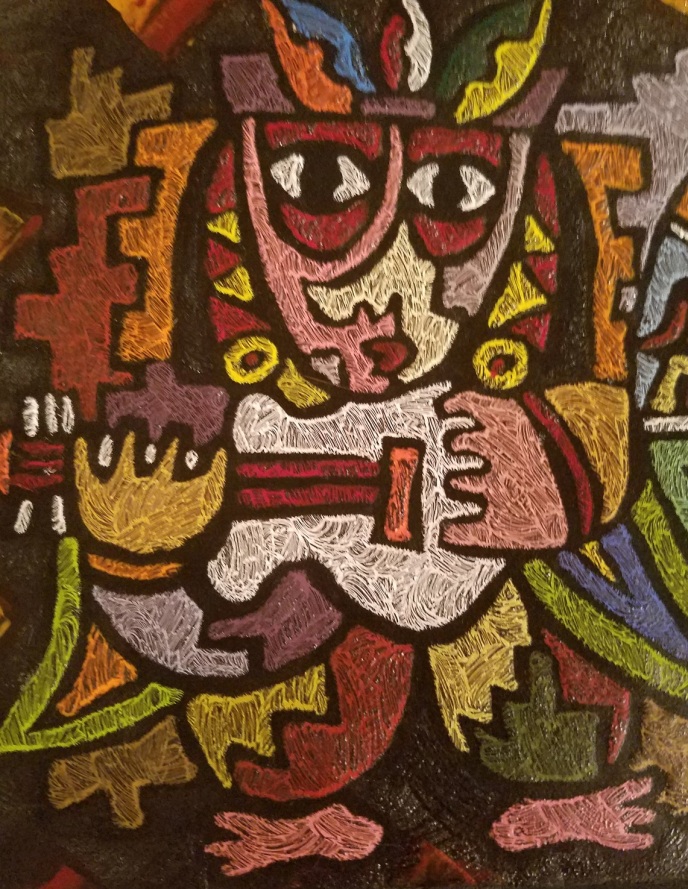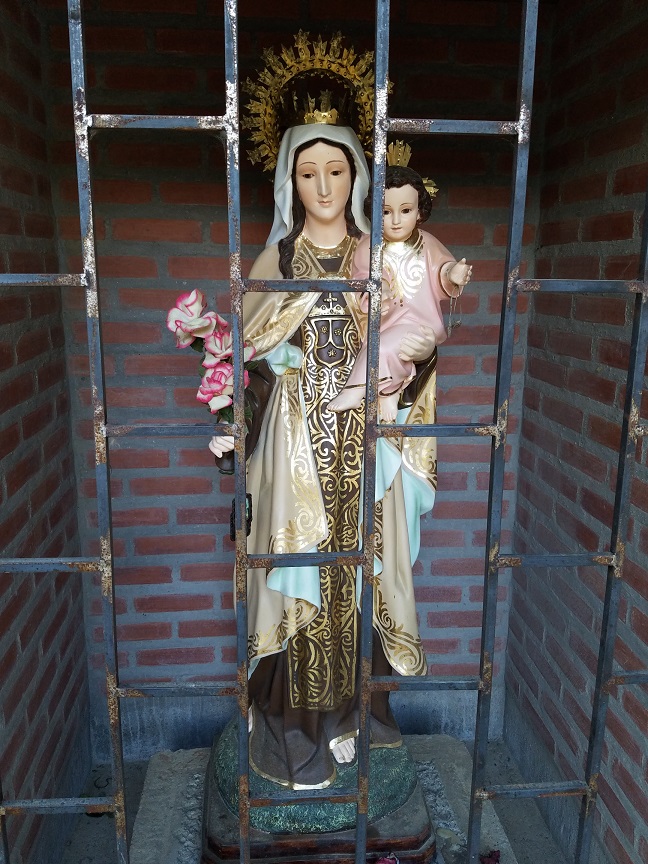Only a Woman, divine, could know all that a woman can suffer.
―

I love the way this Madonna and Child are placed ‘inside’ the living space.
Shrines to the Virgin Mary (often simply called a Madonna—and not of the singing variety😉) are as ubiquitous in Latin America as statues of Buddha are in Southeast Asia. Some Madonnas are culture-specific such as the Virgin of Guadalupe who can be seen adorning myriad spaces in many areas of Mexico. Outside the normal church setting, Madonnas can be spotted on street corners, in neighborhood parks and at the entrance to apartment buildings and individual houses.

Madonna and Child situated in a cozy nook just outside the front door of this house.
Images of the Virgin Mary have held an important place in Christian iconography since the 5th century when they became symbols of Marian devotion soon after the Council of Ephesus formally sanctioned Mary as Mother of Jesus (in Latin, Mother of God).

A mosaic Madonna created in the style of the early Christian church.
Ahhh, the syncretic nature of religion
I’ve heard evangelical Christians in the USA complain that Latinos’ worship of the Virgin Mary is a form of idolatry, but I take issue with that characterization. If one examines the historical background of these cultures, you will see that the Catholicism brought by the Spanish conquerors in the 15th and 16th centuries blended with the animistic beliefs of the indigenous inhabitants who often worshiped a Earth Mother figure or spirit, such as Pachamama in the Andean regions of South America.

A contemporary Peruvian interpretation of Pachamama.
Therefore, it’s completely logical to expect the local populations to transfer that special reverence to a female figure in Christianity and the Virgin Mary was really the only choice left by the censors of early Christian texts. While representations of El Señor (Jesus) still take center stage in most churches in the region, the Virgin Mary is never far away.

A lovely garden Madonna.

A roadside Madonna and Child.
No more machismo please
Another possible reason for Latin America’s special reverence for the Mother of Christ is the region’s culture of machismo where males are often domineering, controlling and violent. As is true in many parts of the world, even though men are in firm control of government institutions, the church and the family, children often feel much closer to their mothers. This in turn establishes a dynamic where children will more readily reveal their secrets and ask for help from a mother rather than a father.

A neighborhood alley Madonna and Child with accompanying angels.
The prayers and devotion given to the Virgin Mary are merely an extension of the love and respect children and adults show to their mothers. When one compares the aesthetic beauty of a statue of the Virgin Mary to one of the truly horrific representations of a bloody, suffering and dying Jesus–as depicted hanging on a cross or lying in a tomb in most Catholic churches in Latin America–it seems obvious that kneeling in front of an image of the Madonna would be far more appealing when someone in need seeks healing or help in a time of crisis.

A typical depiction of the crucified Christ as found in many churches in Latin America.
While Madonna’s can be found wherever Catholic and Eastern Orthodox populations live, these symbols of devotion and comfort really reach their zenith in Latin America. I’m especially fond of the less ornate, more humble images found in family neighborhoods in this region.

A simple and serene white Madonna in a garden.
peace~henry



Beautiful
LikeLiked by 1 person
Thanks Jane!
LikeLike
I agree. Religious males absolutely hate it when women get any attention at all. The bottom statue is lovely.
LikeLiked by 1 person
Agree @hitandrun1964. It’s mind-boggling that women in 2019 are still refused positions of responsibility and influence in most of the world’s dominant religions!
LikeLike
Men will not give up any power they believe they have. They only feel good about themselves when they are crushing others and getting their own way. They’re pathetic.
LikeLiked by 1 person
Great photos. Are all of these from Colombia? -Rebecca
LikeLiked by 1 person
Hi Rebecca,
Yes, I photographed most of these Madonnas in small Colombian towns. The 2 exceptions are: 1) the mosaic Madonna–at a church in Lima, Peru, and 2) the white Madonna–at the Puerto Vallarta, Mexico botanical gardens.
LikeLiked by 1 person
Have you visited the temple of the Virgen de Guadalupe outside Mexico City?
LikeLiked by 1 person
No, sadly, I haven’t Rebecca. I hope I can return to Mexico City and stay for an extended period of time. There’s SO much i didn’t see when I visited in 2016.
LikeLiked by 1 person
Interesting possible explanations of what the evangelicals term Mariolatry, Henry. Personally I wouldn’t be surprised if it’s a response to the overly patriarchal images of God over the centuries that the evangelicals are now happy to promulgate. If the metaphor of God Our Mother could have been used equally to God our Father then things might be different. This is just another aspect of your reasoning.
LikeLiked by 1 person
Hi Denzil,
Yes, the patriarchy has certainly been (and still is) in firm control of religious teachings in most of the world’s major religions. What’s interesting is that in traditional indigenous societies, many women were shamans and therefore had a great deal of influence over the belief systems of a local population. Women were often afforded an equal status to men because in hunter/gatherer cultures everyone was of equal importance. Once people began settling into agricultural societies, attaining wealth and possessions, those traditional roles changed and women were subjugated to an inferior status and basically became yet another possession.
It seems that since we’ve progressed far beyond those agricultural roots at this point in human history that the pendulum is finally swinging in the opposite direction once again, although not without a fight from the males in charge. Evolutionary changes happen so slowly that it’s difficult to know if a trend will continue, but I’d say women have made great strides toward equality over the past century. It just often feels like too little too late, as men continue to rapidly destroy our planet and its inhabitants due to their toxic masculinity.
LikeLiked by 1 person
I didn’t realise it can be traced back to the rise of agricultural practices. Makes sense.
Ah, toxic masculinity in religious belief, the Bible, the church … I’m sure there’s plenty of blogging material there. David’s adultery hushed up while Bathsheba gets the blame. Solomon’s wives and concubines. Modern-day sexual intimidation by famed church leaders. Probably best to focus on the positive aspects of the changes that are occurring.
If only Julian of Norwich could have been listened to a bit more (or could now): “As truly as God is our Father, so truly is God our Mother.”
LikeLiked by 1 person
[“As truly as God is our Father, so truly is God our Mother.”]
Thanks for adding this wonderful quote!
LikeLiked by 1 person
Having been raised an Anglo-Catholic Anglican (although I did attend an Evangelical Protestant Church in my 20s), I have seen both sides of this question of Marian devotion.
Researching the subject in depth on my own, it would probably come as a shock to my Evangelical Protestant friends that the woman clothed with the sun in Chapter 12 of the Book of Revelation is the Virgin Mary.
Although the image does allude to both Israel and the Church (and why not since Mary is a daughter of Israel and the Mother of the Church), the image is primarily referring to the Virgin Mary.
And that’s because the imagery Saint John is using in his Book of Revelation corresponds to Old Testament prophecy about the coming of the Messiah.
A lot of Old Testament messianic prophecy has been preceded by talk of the Ark of the Covenant (which contained the Mosaic tablets that Moses brought down from Mount Sinai and was also supposed to be the dwelling place of the presence of God among His people).
Of course the thing about the Ark of the Covenant is that very specific details were supposed to be given about its construction and consecration and it was supposed to be pure and holy and uncontaminated in order to be able to hold the presence of God.
The Ark of the Covenant was later behind the veil of the Holy of Holies- the most sacred spot in the whole Temple in Jerusalem -which only the High Priest- after an intense period of purification beforehand- was allowed to enter once a year.
So the Ark of the Covenant – a material object- made of material elements such as precious stones- had to be pure, holy and undefiled- in order to hold the presence of God.
And ironically, evangelical Protestants who at the same time are supposed to believe that Jesus is God Incarnate, say that the woman of flesh and blood who carried Jesus (God among us) in Her womb for 9 months was not pure, holy and undefiled?
What was considered vital for the presence of God in the Old Testament covenant – a holy pure and undefiled vessel (that was the Ark of The Covenant) is not vital for the presence of God in the New Testament covenant – a holy, pure and undefiled vessel?
The woman who carried God Incarnate in her womb for 9 months was not holy, pure and undefiled?
Of course evangelical Protestants are always fond of quoting the Apostle Paul’s statement that “only one is without sin” referring to Christ Jesus.
Of course the trouble is in the original Greek, the word used for one there is “henos” (meaning one of a very select or small few) and not “monos” (which does mean “solely and uniquely one” – from which we get our English word “monogamy” – which means marriage to solely one)..
Just like hockey player Wayne Gretzky is called the Great One.
That doesn’t mean he was the only player ever to play the game of hockey.
It just means that he was a distinct – very small select few- caliber of player- of which Mario Lemieux, Bobby Orr and Gordie Howe come close.
Why if Jesus was the only sinless person did Paul use henos and not monos?
It was because the woman who carried Jesus in Her womb would have to be sinless as well.
Just like the vessel they called the Ark of the Covenant (that carried the presence of God) was pure, holy and undefiled.
The last verse of Revelation Chapter 11 talks about the Ark of the Covenant and then lo and behold the 1st verse of Revelation Chapter 12 talks about the Woman Clothed With The Sun (who is the Virgin Mary if you follow Old Testament prophecy and its fulfillment in the New Testament to its logical conclusion).
That is of course why Mary the Mother of Jesus is worthy of veneration.
Latino Catholics have it right.
And U.S. Evangelical Protestants have it wrong.
LikeLiked by 1 person
Hi Christopher,
Somehow I feel like you’ve been waiting a long time to get this out. 🙂 Thanks for sharing your deep knowledge of Biblical history with readers. Luckily I grew up in a Southern Baptist church and had my share of Bible study so I was able to follow along. I’d love to hear your thoughts on the Holy Trinity some time. 😉
LikeLiked by 1 person
Ah yes, the Holy Trinity.
The Mystery that Saint Augustine said no man should try to explain.
Then having said that, he then proceeded to write a book to try to mathematically prove the Trinity,
A book which the computer engineer who designed the computer networks for DARPA, NSF Net and Commerce Net (which became the mathematical basis for Tim Berners-Lee’s World World Wide Web and the Internet) used as the basis to link computers together in a single network.
He was trying to figure out a way to link computers together in a single network in order to develop the systems for DARPA, NSF (National Science Foundation) Net and Commerce Net (an organization linking business computers together).
For his undergraduate degree, he had taken a B.A. in Thomistic theology at Boston College.
He had also read Augustine’s book trying to mathematically prove the Trinity.
It suddenly occurred to him that if Augustine was trying to prove how 3-in-1 and 1-in-3 amounted to the same thing, maybe the book might prove useful to provide the math to link computers together in a single network system.
And the book did provide the key.
Augustine’s math in trying to mathematically prove the Trinity became the math he used for developing networks of computers for DARPA, NSF Net and Commerce Net (that Tim Berners-Lee expanded into the World Wide Web).
So say what one will about the Mystery, Paradox and Doctrine of the Holy Trinity, I’m always delighted by the fact that if Augustine hadn’t ignored his own advice and set out to mathematically prove the Trinity, we might not have the Internet today.
And it’s for this reason that I think Augustine should be given the title Grandfather of The Internet or maybe Great-Grandfather of The Internet.
LikeLiked by 1 person
I suppose I was coaxing you into further sharing. 🙂
So, if we accept St. Augustine’s role in creating the internet–based on his attempts to mathematically prove the Holy Trinity–does it then follow that “The Beast” as described in the book of Revelation is the internet, coming full circle as it were?
LikeLiked by 1 person
I have read books that argue a compelling case for the Beast being a form of AI cyborg human hybrid.
I don’t think the Internet itself is the Beast.
I’ve also read books that suggest the coming 5G Network will pave the way for implementing the Mark of the Beast.
And then of course the U.S. government can’t handle the fact that China is eons ahead of them in developing a 5G Network so they get the Canadian government to arrest Huawei CFO Meng Wanzhou (which the Canadian government stupidly went along with) on trumped up charges of violating U.S.sanctions on Iran since Huawei has been the most preeminent company in developing 5G.
Now two Canadians are in jail in China and another one will be shot by firing squad as a result of Canada’s government blindly kissing the Trump Administration’s ass in its trade and technology war with China.
LikeLiked by 1 person
Yes, I’ve been following the Huawei saga–bizarre. Living abroad for years, I can empathize with the way the 2 Canadians must feel who were most recently detained in China. I’m wishing them a safe and prompt release. The 3rd one who’s been sentenced to death must be devastated. Does the Chinese government still send a bill for the bullet to the executed’s family? The world is a cruel place for all but the most powerful.
LikeLiked by 1 person
Yes, the Chinese government still does that.
And the world still is a cruel place for all but the most powerful.
And I don’t think my country’s Prime Minister Justin Trudeau has figured that out yet- being the son of an academically inclined Platonic philosophy and constitutional law professor who acted much the same way on the world stage when he was Prime Minister.
LikeLiked by 1 person
An insightful and beautiful post, Henry. The Brazilian people also have a great devotion to Mary, the Mother of Jesus.
Earlier this week, a friend also complained that “Latinos’ worship of the Virgin Mary is a form of idolatry.” I love the way you explain the reason for such devotion.
LikeLiked by 1 person
Thanks Rosaliene. We all owe such a debt to our Mothers, but especially to our great Mother Earth.
LikeLiked by 1 person
I’m not religious, but I like the history, and the statues.
Thank you for the informative post!
LikeLiked by 1 person
Yes, it’s the same for me Resa. I’ve collected Buddha carvings from all over East Asia and enjoy them based on their artistic merits and historical cultural meaning. I enjoy seeing different Madonnas for the same artistic, symbolic and cultural reasons.
LikeLiked by 1 person
Wonderful post!!!
LikeLiked by 1 person
MADE ME THINK – ALWAYS GOOD TO SLOWLY PROCESS !!!!
LikeLike
Thanks for saying that!
LikeLike
Thanks so much!
LikeLike